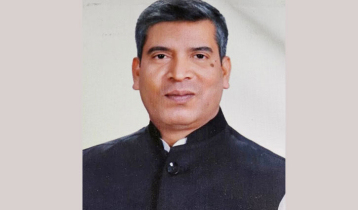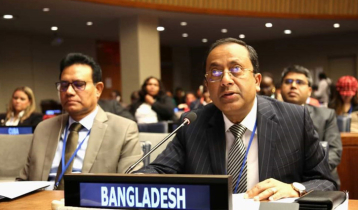Obesity, a serious public health threat
Manzurul Alam Mukul || risingbd.com

Two overweight kids
Manzurul Alam Mukul: It is said that obesity is a disease of the past. The obesity epidemic now continues its alarming increase worldwide including Bangladesh. At present almost 40 percent of adults everywhere are overweight or obese, more than doubled since 1980.
Overweight and obesity are caused by many factors. For each individual, body weight is determined by a combination of genetic, metabolic, behavioral, environmental, cultural and socioeconomic influences. But, behavioral and environmental factors are large contributors to overweight and obesity. For the vast majority of individuals, overweight and obesity result from excess calorie consumption and/or inadequate physical activity.
A recent study published in The Lancet (UK medical journal) shows that food consumption habits are worsening across the developing world, raising the likelihood of a double burden of obesity and malnutrition in poorer countries.
Bangladesh is pegged to become a middle-income country by 2021, following substantial improvements in public health, education and poverty reduction since 1990.
The study, which analysed the eating habits of people in 187 countries in 1990 and 2010, attributes expanding waistlines to worsening food consumption habits.
The study did not provide in-depth analyses of Bangladesh, but it is known that obesity and overweight are increasing in the country.
And the results from this large global study will provide lessons for Bangladesh, where the risks associated with poor eating habits may already be creating a dual burden still dealing with under-nutrition.
In previous studies, for example, some 17.6 percent of schoolchildren in Bangladesh were still found to be underweight in 2009. And while rates of stunting in Bangladesh have gone down considerably—by 31% in some rural areas – obesity is also on the rise.
Even though the rates are still low-less than 3% in 2012, according to one study – the absolute numbers of obese rural Bangladesh children have more than doubled in just 13 years.
The results of The Lancet paper, which evaluated dietary consumption on a country-by-country basis based on micronutrient quality, imply that any growing cohort of obese Bangladeshi children will not well nourished either.
The dietary quality of almost every region of the world has worsened based on the increased consumption of unhealthy food since 1990, but improvements in the consumption of healthy foods were limited to just the high- and middle-income countries.
In the last two decades there has been a major reduction in undernutrition and a considerable increase in obesity in children in Bangladesh, creating a dual burden of poor nutrition.
A recent icddr,b studies exploring nutrition trends in Bangladesh confirm that overweight and obesity are serious public health threats, especially among children, and it is causing huge deaths every year.
While the systematic analysis of national prevalence for overweight and obese adults and children in Bangladesh for the Global Burden of Disease Study 2013 found that less than 2 percent of the population is obese, a separate scoping review of the literature found that the prevalence could actually range from 1 percent to 17.9 percent, depending on the reference standard.
Indeed, another recent icddr,b study, which looked at the urban-rural divide in childhood nutrition, found that almost 20% of rural children are still underweight, and therefore at a higher risk for diarrhoeal diseases and infection, while 5.6% of urban children are now obese, and therefore susceptible to diabetes, metabolic disorders and heart problems in later life.
Health risks
In fact, the leading causes of death in Bangladesh in 2013, identified by the Global Burden of Disease Study, were stroke, ischemic heart disease and chronic obstructive pulmonary disease. Obesity is a precursor to all three of these non-communicable diseases, and it is caused by a poor diet and unhealthy lifestyle.
Epidemiological studies show an increase in mortality associated with overweight and obesity. Individuals who are obese (BMI > 30) have a 50 to 100 percent increased risk of premature death from all causes compared to individuals with a BMI in the range of 20 to 25.
A weight gain of 11 to 18 pounds increases a person`s risk of developing type 2 diabetes to twice that of individuals who have not gained weight, while those who gain 44 pounds or more have four times the risk of type 2 diabetes.
Overweight and obesity are also known to exacerbate many chronic conditions such as hypertension and elevated cholesterol. Overweight and obese individuals also may suffer from social stigmatization, discrimination, and poor body image.
Financial loss and sufferings
The increasing prevalence of overweight and obesity is associated with both direct and indirect costs. Direct health care costs refer to preventive, diagnostic, and treatment services related to overweight and obesity (for example, physician visits and hospital and nursing home care). Indirect costs refer to the value of wages lost by people unable to work because of illness or disability, as well as the value of future earnings lost by premature death.
Disparities in the prevalence of overweight and obesity also exist based on socioeconomic status. For all racial and ethnic groups combined, women of lower socioeconomic status.
Although obesity-associated morbidities occur most frequently in adults, important consequences of excess weight as well as antecedents of adult disease occur in overweight children and adolescents. India, our middle-income neighbour and malnutrition contemporary, is already the third most obese country in the world by population. The obesity epidemic now continues its alarming increase in Bangladesh. In the circumstance, to prevent this epidemic from engulfing Bangladesh, experts opine that there need an appropriate health policy to guide future heath programmes and policies on nutrition. People should be made awareness about calorie consumption and physical activity through different health programmes. Health related matters including calorie consumption and physical activity should be included in academic curriculum.
It can be here mentioned that, sports and games play an important role in maintaining one`s physical fitness. But it has now become impossible due to lack of playgrounds and open space.
Earlier, there were many open places and playgrounds used to play but now we don`t find many empty places countrywide, especially in Dhaka city. The open space has been shrinking day by day. Our children are being deprived of healthy childhood and most of them spending their time before TV and computer which tells upon their physical and mental health. Many open places are now being used as parking places of vehicles. It is sad to know that only 21 playgrounds are available for nearly 20 million people of Dhaka. So, besides the government, all of us should come ahead to build open places and playgrounds, identify open places and fields and preserve those.
risingbd/Dhaka/April 22, 2015
risingbd.com


































